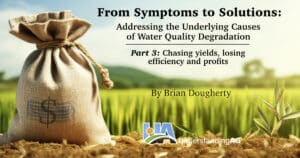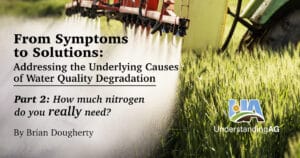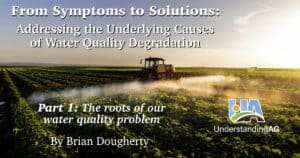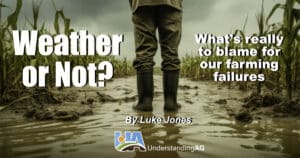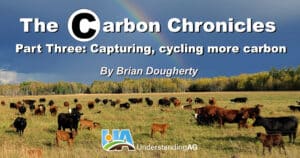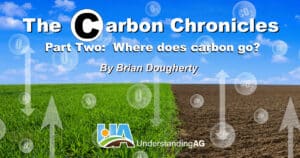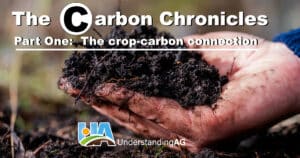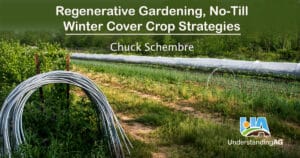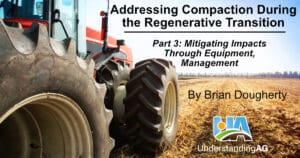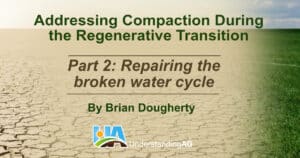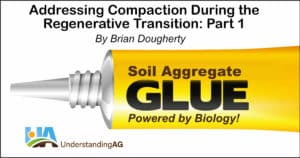In business, it all comes down to profit. In farming, profit comes down to things we can’t control like the weather and the markets, and the things we can control like our management decisions. One of those key management decisions is determining how much nitrogen to apply to our crops. In part two of this […]
Read MoreIn part one of this series, I briefly discussed the importance of education for understanding how soil function and ecosystem processes play a critical role for water quality. Now let’s turn our attention to determining the “right rate” for nitrogen. Nutrient management plans focus heavily on nitrogen because it is critical for plant growth and […]
Read MorePoor water quality has been a persistent challenge in agriculture, particularly due to sediment and nutrient loss from farmland. It is considered a “wicked problem” with conflicting social, political, economic, and environmental aspects that prevent solutions. In this blog series I will challenge the notion that degraded water is something we all have to live […]
Read MoreMost of us have heard the old sayings regarding weather and farming including, “Don’t plant until the barn swallows return,” and “Wait until the oak leaves are as big as a squirrel’s ear.” These, and many other sayings, were tied to observations and farming in sync with what Mother Nature was telling us in terms […]
Read MoreThe first two parts of this series examined the critical role of carbon in powering plant and soil life (all terrestrial life) and the cyclic outflow from an average corn field. Now let’s look at inflows. Unsurprisingly, the lack of photosynthesizing plant cover throughout the growing season makes the carbon inflows smaller. Maintaining living cover […]
Read MoreI’m a traveler unseen, in cycles I flow, From the air to the earth, far down below. Plants welcome me in their leafy grace, As part of a process, essential to embrace. I dance with the sun, in the atmosphere high, Yet in oceans and soil, you’ll find me nearby. Roots release me when they […]
Read MoreIn soil I lie, a secret unseen, A cornerstone of life, in every green. With humble microbes, a dance serene, In Earth’s embrace, my role is keen. In the ground I dwell, unseen but grand, A vital link in life’s command. With microbes and roots, a partnership planned, In the soil I’m hidden, yet readily […]
Read MoreWhen I began studying ornamental horticulture and landscape design over 25 years ago, regenerative agriculture was just a twinkle in Gabe Brown’s eye and a glimpse of the future in the eyes of Allen Williams’, Ph.D. For me, well, I was taking an introductory soil science class in a two-year horticulture degree program at Farmingdale […]
Read MorePlanning Winter Cover Crop Rotations Maximizing cover crop benefits in the garden requires strong crop planning with strategic rotations coupled with creative improvision so it’s important to examine strategies and considerations for incorporating cover crops with no-till methods and inter-seeding. These strategies can apply to the market gardener or home gardener, and have applications for […]
Read MoreIn parts one and two of this series, we reviewed the role of biology and the importance of living roots, aggregated soil, and a functioning water cycle for building strong, compaction-resistant soils. Now let’s look at the equipment and field management practices that can help mitigate compaction while you transition to a regenerative system. Compaction […]
Read MoreIn part one of this series, we reviewed the fundamental role that biological glues and soil aggregates play in creating healthy, strong soil that resists compaction. Given the importance of living roots that drive aggregate formation, how can we use that to our advantage to remediate and prevent compaction? Living roots not only build aggregates, […]
Read MoreSoil compaction is the most common problem that I have encountered on farms as I travel across the Midwest. It is so prevalent that it’s easy to forget that compaction is a symptom, not an inherent property of soil. It is the result of poor soil function, which is the result of management practices that […]
Read More
